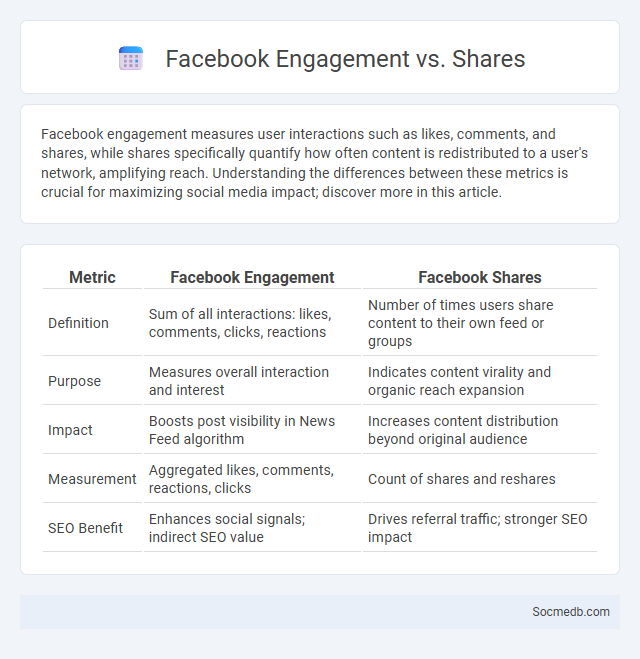
Photo illustration: Facebook Engagement vs Shares
Facebook engagement measures user interactions such as likes, comments, and shares, while shares specifically quantify how often content is redistributed to a user's network, amplifying reach. Understanding the differences between these metrics is crucial for maximizing social media impact; discover more in this article.
Table of Comparison
| Metric | Facebook Engagement | Facebook Shares |
|---|---|---|
| Definition | Sum of all interactions: likes, comments, clicks, reactions | Number of times users share content to their own feed or groups |
| Purpose | Measures overall interaction and interest | Indicates content virality and organic reach expansion |
| Impact | Boosts post visibility in News Feed algorithm | Increases content distribution beyond original audience |
| Measurement | Aggregated likes, comments, reactions, clicks | Count of shares and reshares |
| SEO Benefit | Enhances social signals; indirect SEO value | Drives referral traffic; stronger SEO impact |
Understanding Facebook Engagement
Facebook engagement measures how users interact with your content through likes, comments, shares, and clicks, providing key insights into audience behavior. High engagement rates indicate your posts resonate with your target demographic, boosting organic reach and brand visibility. To maximize your Facebook engagement, consistently create relevant, interactive content tailored to your audience's interests and preferences.
What Are Facebook Shares?
Facebook shares refer to when users repost content on their timeline, allowing it to reach a broader audience beyond the original post's visibility. This action boosts engagement metrics such as reach and impressions, enhancing your content's viral potential. Understanding how Facebook shares work helps you leverage social media marketing strategies effectively.
Key Differences Between Engagement and Shares
Engagement on social media encompasses all interactions, including likes, comments, and shares, reflecting overall user activity and interest in content. Shares specifically denote when a user redistributes a post to their network, amplifying its reach and potential virality. Analyzing shares provides insights into content resonance and organic growth, while engagement metrics offer a broader measure of audience connection and content effectiveness.
Types of Facebook Engagement Metrics
Facebook engagement metrics include likes, comments, shares, and reactions that gauge user interaction with content. Video views and click-through rates further quantify audience interest and behavior on posts. Tracking these metrics helps optimize content strategies and improve overall reach and engagement on the platform.
Why Facebook Shares Matter
Facebook shares significantly increase your content's reach by exposing it to a wider and more diverse audience beyond your immediate followers. These shares improve your post's visibility in the Facebook algorithm, boosting engagement rates and driving more organic traffic to your page or website. When users share your content, it builds social proof and trust, enhancing your brand's credibility and influence across the platform.
Engagement Rate: How It’s Calculated
Engagement rate is calculated by dividing the total interactions (likes, comments, shares) by the total number of followers, then multiplying by 100 to express it as a percentage. This metric reflects audience interaction and content effectiveness across platforms like Instagram, Facebook, and Twitter. Higher engagement rates indicate stronger community connection and content relevance.
The Role of Comments and Reactions
Comments and reactions on social media platforms play a crucial role in enhancing user engagement and fostering community interactions. They provide valuable feedback for content creators and algorithms, influencing content visibility and audience reach. These interactive features also enable real-time conversations and sentiment analysis, helping brands to gauge public opinion and tailor their strategies effectively.
Boosting Engagement vs. Increasing Shares
Boosting engagement on social media involves tactics like interactive content, personalized responses, and timely postings to foster user interaction and loyalty. Increasing shares hinges on creating highly relatable, valuable, and share-worthy content that resonates emotionally or intellectually with the audience. Both strategies impact brand visibility, but boosting engagement builds community depth while increasing shares expands reach and potential audience growth.
Which Matters More: Engagement or Shares?
Engagement metrics such as likes, comments, and shares provide insights into how your audience interacts with your content, but shares often carry more weight in amplifying your message beyond your immediate followers. When your content is shared, it reaches new audiences organically, increasing your brand's visibility and potential for viral growth. Focusing on creating share-worthy content will boost your social media presence more effectively than engagement alone.
Best Practices for Maximizing Both Engagement and Shares
Leveraging visually appealing content paired with concise, relatable captions significantly boosts user engagement on social media platforms. Timing posts during peak activity hours and incorporating interactive elements like polls or questions encourages shares and expands reach. Consistently analyzing platform-specific analytics helps refine strategies for maximizing both engagement and shares.
 socmedb.com
socmedb.com